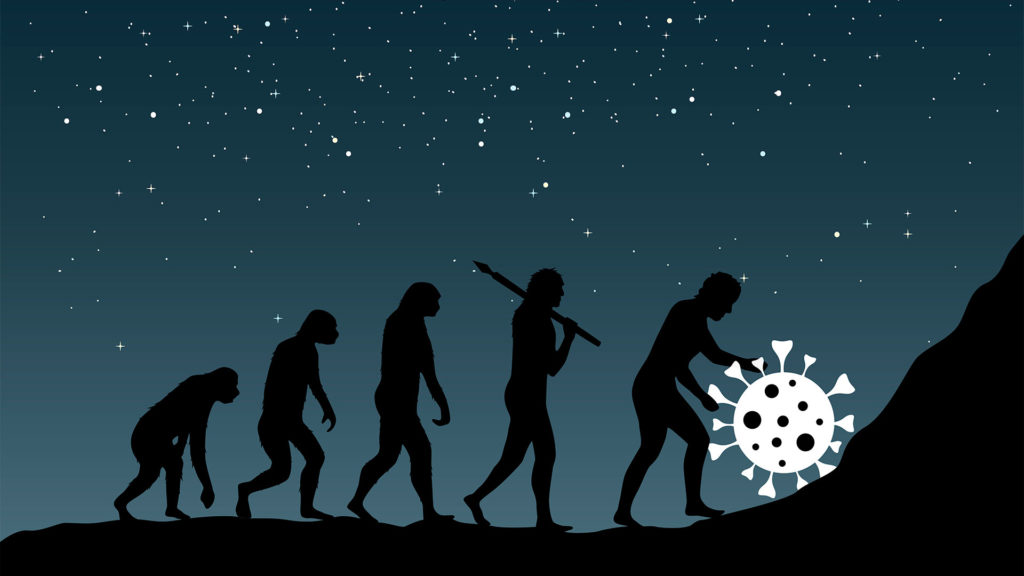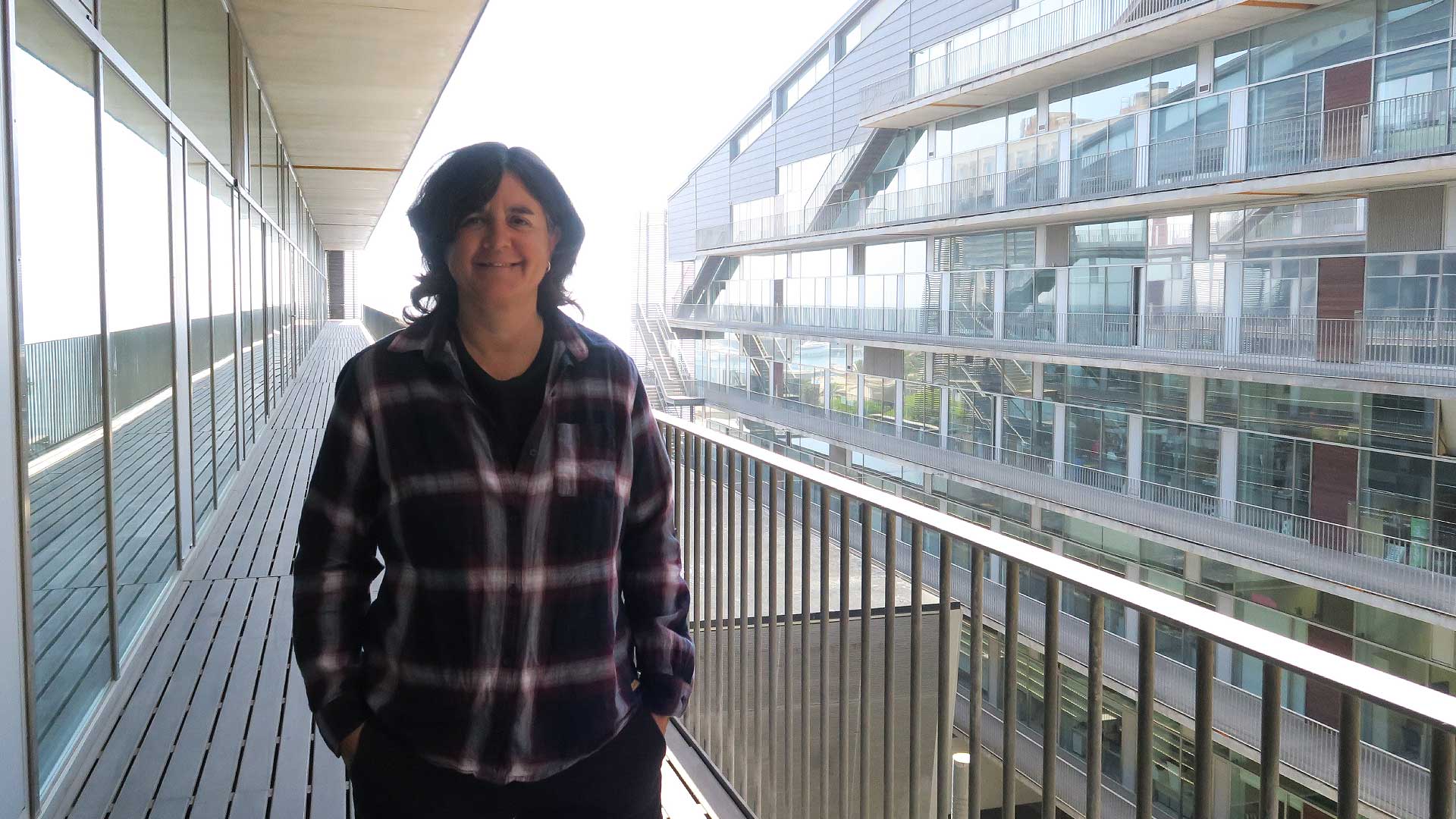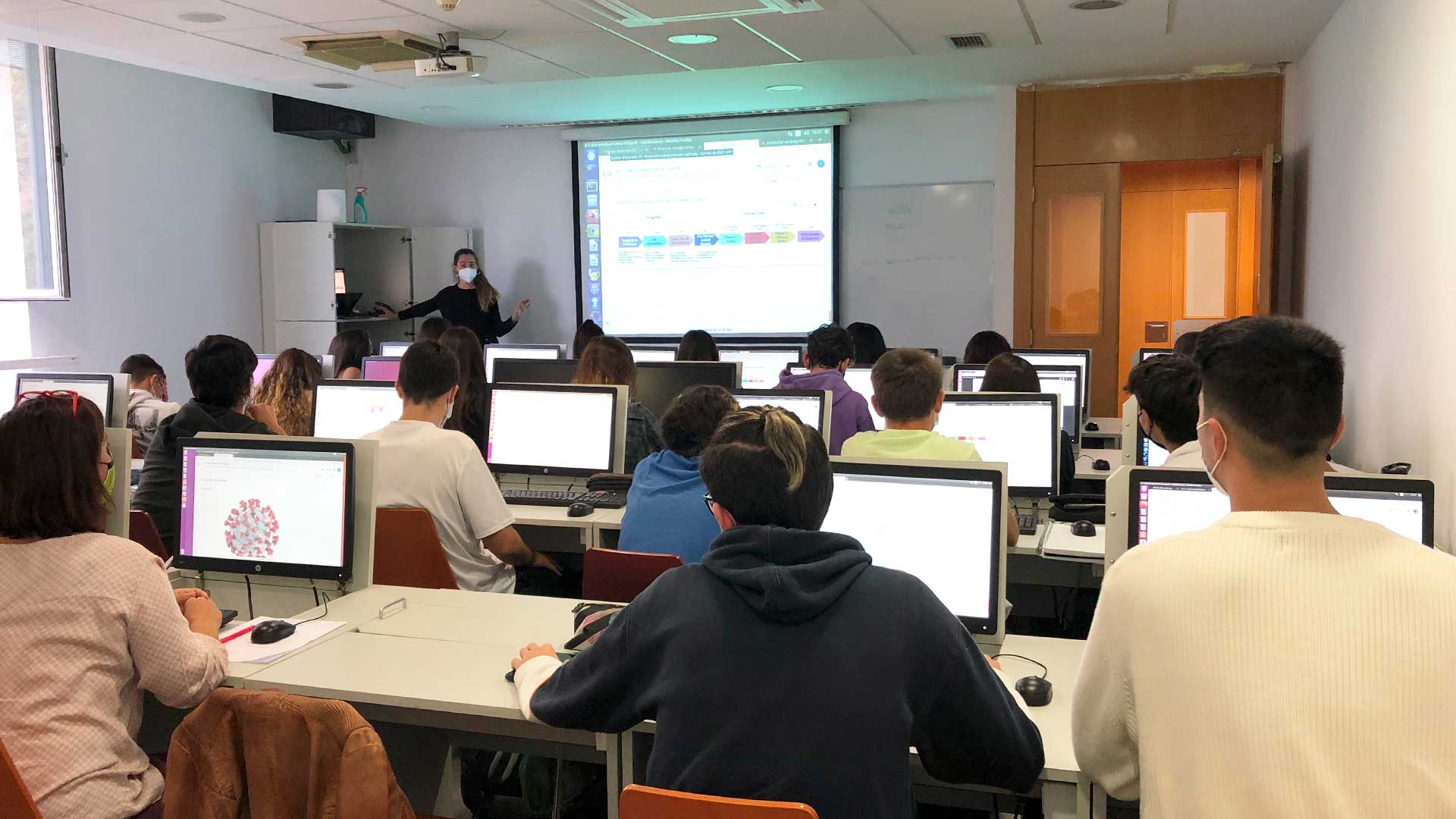Oscar Lao, professor at BDBI, shares his knowledge about how SARS-CoV-2 and COVID-19 are behaving from an evolutionary point of view. A very interesting analysis from the past to try to figure out where this pandemic situation is going to lead us.
COVID-19 is a multiorgan disease produced by the infection of the severe acute respiratory syndrome coronavirus 2 (SARS-CoV-2). A virus of 29.8 kb to 29.9 kb of genetic material from the family of coronaviruses (CoVs). Viruses from this family are known to cause severe diseases in humans and animals. Initially reported at Wuhan (South China) at the beginning of January 2019, the virus rapidly spread all over the world. At first glance, it can seem surprising that such a tiny and simple pathogen (compared to the 3Gb of genetic material present in humans) could have struck so severely our health, society and economy.
However, looking at the past, we could see that this situation is not exceptional. The modus operandi of SARS-CoV-2 –and its consequences- resembles other historical pandemic outbreaks, such as the Black Death (due to the bacterium Yersinia pestis) in the Middle Ages, the miscalled “Spanish flu” in 1918 (due to a strain of the influenza virus) or AIDS in the eighties of the last century (due to HIV virus), among many others. In all these pandemic outbreaks, a pathogen traditionally infecting a non-human animal host species is able to infect our species (a process called zoonosis) and, after this first step, it is able to go from human to human. However, not all the pathogens that follow this path reach the epidemic status of a pandemic. The reason why COVID-19 has been able to generate it compared to other infectious diseases is multifactorial, and all of these reasons have to do with evolution.
In order to make a zoonosis, the original host of the pathogen and humans must closely interact, so the pathogen can have a way to get in touch with humans. The reduction of biological diversity, the destruction of natural habitats -bringing humans in contact with new exotic species-, the climate change -allowing host species to spread to new locations-, and the exponential growth of humankind, among other ecological and demographic factors, provide the perfect breeding ground for zoonosis episodes. In other words, this was not unexpected, and the question was when and where was it going to happen. In fact, Vincent C. C. Cheng and colleagues had already warned about the possibility of new SARS-CoV-like infections in southern China due to the large reservoir of these viruses in horseshoe bats, and the culture of eating exotic mammals (in 2007!). Furthermore, recent studies suggest that this is only one of many other diseases that could jump from other animals to us in different parts of the world, so we can expect this to happen more frequently as we keep messing up with the environment.
An evolutionary point of view
From an evolutionary point of view, when the environment for which a species was adapted suddenly changes, the species must become biologically adapted to the new environment, or the species has to change again the environment to set it to an equivalent state as before the change (a third possibility is to get extinct, of course). A classic example suggested for humans is the presence of cavities in modern societies. Cavities are produced by the infection of the microflora living in our buccal cavity. They can lead to serious health complications if not properly treated. Nowadays, cavities are quite frequent, and we regularly require a dentist to prevent and to erase them, as well as having regular oral hygiene habits.
How did our hunter-gatherer ancestors manage to survive with such a large amount of cavities without the modern methods we have nowadays to treat them? The answer is that cavities were quite infrequent in Paleolithic times. They existed and can be identified in ancient remains, but at low frequency. They started increasing after the Neolithic when human populations developed farming. What has changed since then? For cavities, mostly the diet. We shifted from a hunter-gatherer type of diet for which likely the microflora was adapted, to another based on the farming, richer in carbohydrates. This change in the environment faced the change of the behavior of the microflora, which led to increasing cavities. Biological adaptation would imply that people that are genetically resistant to cavities tend to have more children. The alternative, less painful for humankind, has been introducing another change in the environment (the dentist).
The point of view of the virus
For SARS-CoV-2, getting in touch with a new host is the equivalent to getting into a new environment. “Evolutionary adaptation” implies that, over the pool of individuals from a species, some will have more chances to reproduce thanks to the presence of inherited genetic mutations. This means that not all the virus particles will be equally efficient invading a new host, and some mutations will provide an evolutionary advantage to overcome cross-species barriers and to spread faster within the new species. SARS-CoV-2 seems to be a clear evolutionary candidate for jumping to other species. A recent study suggests that CoVs viruses have a long story of recombination and that SARS-CoV-2 could have appeared by cross-species recombination between bat and pangolin CoVs, allowing it to infect other species.
Furthermore, in a masterful evolutionary application of the law “minimal effort / maximum reward”, the pathogen initially uses the same tricks to fool the defenses of the new host that it applied to the original host. This implies that not all the pathogens that infect one species can break the cross-species barrier and infect us. Some molecular homologies at the protein level in terms of sequence and folding shaped by evolution must exist between the host and the receptor species. For example, SARS-CoV-2 uses our receptor of the protein ACE2, which is particularly conserved across the evolution of specific metazoans, plants, fungi and protists, to infect our cells. Therefore, jumping from one species to the human (and to many others, as we already know) has not been difficult for the virus.
Moreover, the pathogen must be able to successfully spread into the new species. For example, Ebola outbreaks, which are also produced by a virus due to a zoonosis, remain relatively geographically restricted –reaching epidemic but not pandemic levels. The main reason is that the transmission is mainly through blood (not an easy thing to exchange between humans in normal conditions) and body fluids, and the period of incubation is reduced. In contrast, HIV is another virus that also spreads through body fluids, but whose time of incubation is large enough so an infected individual can spread it to other individuals without noticing it. In COVID-19, both characteristics apply. The virus uses a relatively easy way of transmission (mainly by aerosols), and the disease impairs a subset of the infected individuals (the others are regarded as asymptomatic).In our global times, this is equivalent to having a free interrail ticket to travel all around the world.
Nevertheless, this does not mean that the virus is not trying to find more efficient ways for infecting us. A recent study suggests that some genetic variants of the virus have been already selected for improving the efficiency of the infection, and new virus strains with a higher potential infectious rate are being reported. In part, this search of new strategies of infection can be expected as the new host (us), in an attempt to prevent the infection, has attacked the basic way of infection by using masks and promoting social distance, among other strategies. Do you remember what we said before about the environment and adaptation? You change the environment (by forcing social distance), and consequently, the pathogen must adapt to find better ways to infect us in order to avoid extinction.
The evolutionary story from the host (us) point of view
This explains only half of the story, as we have only seen the pathogen perspective. Following what we have said, we can think that the virus infection is the “change of environment”. Therefore, we need to fulfill the parts of the evolutionary equation that we have introduced before: either we biologically adapt, or we change the environment again. The latest is the most direct way, and we have referred to it before even if not stating it explicitly: masks, hygienic protocols (i.e. hydroalcoholic gel) or social distance are some of the environmental changes that the authorities have proposed for stopping the spread of the virus.
Other strategies, such as vaccines, new medical treatments or new technological advances to detect asymptomatic carriers and people that are already immune, are on the road. However, since the ultimate meaning of life is, from a biological point of view, to make copies of itself to endure over time, it is likely that the virus will try to adapt to any new attempt of changing its environment, using also the same evolutionary principles we have so far discussed. It is a race! In fact, we know it is already doing it now. The key message out of it is that the complete eradication of an infectious disease is usually tough unless the capacity of the pathogen for adaptation to new environments is more limited than the rate at which we change them. Nevertheless, there are some cases where eradication has been successful (e.g. smallpox, which could not adapt to the new environment created by the vaccine).
For us, fulfilling the first part of the evolutionary equation is a bit more complex and macabre. It requires the selection of individuals that are biologically resistant to the virus to produce more offspring compared to the ones that are susceptible to the virus. We have evidence that some genetic variants in our genome have been selected for producing resistance to previous pathogens, showing that selection against infectious diseases has been common in our evolutionary history. Can we expect this to happen here too? Recent studies suggest that there are genetic variants in our genome that provide susceptibility or resistance against some of the most severe COVID-19 symptoms.
It must be stated that these variants so far explain a very modest amount of the susceptibility to the disease. This is usually the case for complex multifactorial phenotypes such as COVID-19, where environment and genetics intermingle. However, these results suggest that from a genetically inheritable point of view we are not equally susceptible to the infection and its effects. Moreover, it has been shown that some of these genetic variants could have been inherited from archaic species such as the Neanderthals, to whom our anatomically modern human ancestors admixed when they migrated out of Africa. Usually, it has been shown that the admixture between anatomically modern humans that migrated from Africa and archaic species that were in Eurasia was detrimental for the hybrid individual. In other words, the introgressed fragments tend to be removed from our genome.
However, individuals with recent ancestry out of Africa carry around 2-3% of Neanderthal ancestry, supporting the existence of archaic ancestors in these populations. Most of these fragments are at low frequencies in the human population, supporting this detrimental effect of the introgressed fragments. However, there are some genomic hotspots of archaic introgressed fragments, suggesting that the incorporation of genomic variants from archaic populations was supported by selective pressures. This seems to be the case for the introgressed region associated to COVID-19. Therefore, it is plausible to think that variants conferring resistance to the COVID-19 infection could be under selective pressures. Since COVID-19 is a new disease, it is likely that these variants provide resistance to other diseases related to the mechanisms that COVID-19 uses for infection and for producing the symptoms.
One can object that it is unlikely that we are under selective pressures for this virus, since the virus is mostly deadly affecting old people, who have already passed the reproductive age or thanks to medical advances. Nevertheless, this is a very simplistic way of analyzing it. First, because in probability, the virus is also affecting young people at reproductive age. Second, because there is no need for the virus to be mortal to have an effect on the fitness of the individuals. We know that the infection can lead to a set of sequels, some of them quite impairing. Third, and perhaps more interesting from an evolutionary point of view, because people out of the reproductive age can alloparental care of biologically related young people, helping their fitness. This is a type of kin selection that has been suggested for explaining human females’ postmenopausal longevity.
In other words, understanding the evolutionary principles of our species and applying the same principles to SARS-CoV-2 can help us understand why SARS-CoV-2 had all the lottery tickets from an evolutionary point of view to make the mess we are facing nowadays. As the evolutionary biologist Theodosius Dobzhansky said in a 1973 essay, “nothing in biology makes sense except in the light of evolution”. This sentence is imprinted in the DNA of any person that courses in “Bio” studies and it plays a fundamental role in the grade of Bioinformatics at ESCI-UPF.




Leave a message